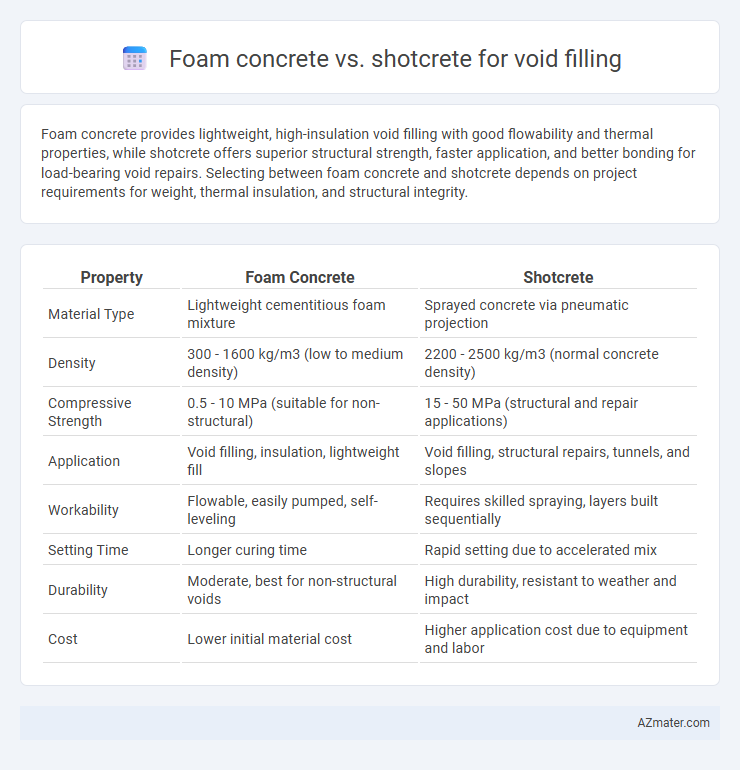Foam concrete provides lightweight, high-insulation void filling with good flowability and thermal properties, while shotcrete offers superior structural strength, faster application, and better bonding for load-bearing void repairs. Selecting between foam concrete and shotcrete depends on project requirements for weight, thermal insulation, and structural integrity.
Table of Comparison
| Property | Foam Concrete | Shotcrete |
|---|---|---|
| Material Type | Lightweight cementitious foam mixture | Sprayed concrete via pneumatic projection |
| Density | 300 - 1600 kg/m3 (low to medium density) | 2200 - 2500 kg/m3 (normal concrete density) |
| Compressive Strength | 0.5 - 10 MPa (suitable for non-structural) | 15 - 50 MPa (structural and repair applications) |
| Application | Void filling, insulation, lightweight fill | Void filling, structural repairs, tunnels, and slopes |
| Workability | Flowable, easily pumped, self-leveling | Requires skilled spraying, layers built sequentially |
| Setting Time | Longer curing time | Rapid setting due to accelerated mix |
| Durability | Moderate, best for non-structural voids | High durability, resistant to weather and impact |
| Cost | Lower initial material cost | Higher application cost due to equipment and labor |
Introduction to Void Filling Solutions
Foam concrete and shotcrete are prominent void filling solutions used in construction and mining to stabilize underground spaces and reduce settlement risks. Foam concrete offers lightweight, self-leveling properties with excellent flowability, making it ideal for large-scale void filling applications requiring uniform density. Shotcrete provides high strength and durability through sprayed concrete that adheres to complex surfaces, suitable for structural reinforcement in irregular void geometries.
Overview of Foam Concrete
Foam concrete is a lightweight, low-density material produced by mixing cement, water, and pre-formed foam to create a highly flowable slurry ideal for void filling in construction. Its cellular structure provides excellent thermal insulation and fire resistance while maintaining sufficient compressive strength for structural support. Foam concrete's ease of placement and ability to conform to complex void geometries make it a preferred choice over shotcrete in many underground and foundation applications.
Overview of Shotcrete
Shotcrete is a pneumatically applied concrete mix known for its high-density application and superior compressive strength, making it ideal for filling voids in underground construction and tunneling projects. Its rapid setting time and excellent adhesion to complex surfaces ensure effective consolidation and structural support in areas where traditional casting methods may be impractical. Shotcrete's ability to conform to irregular void shapes while providing durability and resistance to water infiltration distinguishes it from foam concrete in void filling applications.
Material Properties Comparison
Foam concrete offers lightweight, high thermal insulation, and excellent flowability, making it ideal for filling large voids with low-density requirements. Shotcrete provides superior compressive strength and adhesion due to its dense, cementitious matrix and is preferred for structural void repairs where load-bearing capacity is critical. Both materials differ significantly in setting time, with foam concrete requiring longer curing periods, while shotcrete hardens rapidly, enabling faster project turnaround.
Installation Process: Foam Concrete vs Shotcrete
Foam concrete installation involves mixing cement, water, and foam to create a lightweight slurry that is pumped or poured into voids, allowing it to expand and fill irregular cavities efficiently. Shotcrete requires pneumatically projecting a dry or wet cementitious mixture at high velocity onto surfaces, providing high compaction and adhesion, especially in vertical or overhead applications. Foam concrete offers simpler, faster placement with minimal rebound, while shotcrete requires skilled labor and specialized equipment but provides superior strength and bonding in structurally demanding void filling.
Strength and Durability Factors
Foam concrete offers lower density and moderate compressive strength, typically ranging from 1 to 15 MPa, making it suitable for lightweight void filling but less durable under heavy loads compared to shotcrete. Shotcrete provides higher compressive strengths exceeding 30 MPa and superior adhesion to surfaces, enhancing long-term durability and resistance to environmental factors like moisture infiltration and freeze-thaw cycles. The choice between foam concrete and shotcrete depends on the load-bearing requirements and exposure conditions, with shotcrete preferred for high-strength, durable void filling in structural applications.
Cost Effectiveness Analysis
Foam concrete offers a lower cost solution for void filling due to its lightweight composition and reduced material requirements, resulting in decreased transportation and labor expenses. Shotcrete, while providing superior compressive strength and faster application in complex voids, typically incurs higher costs from specialized equipment and skilled labor. Evaluating overall cost effectiveness depends on project scale, void complexity, and performance requirements, with foam concrete favored for economical large-scale void filling and shotcrete preferred for structural reinforcement despite its premium pricing.
Environmental Impact and Sustainability
Foam concrete offers superior environmental benefits for void filling due to its lightweight composition, lower cement consumption, and enhanced thermal insulation properties that reduce energy usage in construction. Shotcrete, while providing high strength and rapid application, typically involves higher cement content and energy-intensive spraying equipment, leading to greater carbon emissions. Choosing foam concrete supports sustainability goals by minimizing resource depletion and reducing the overall carbon footprint of void filling projects.
Common Applications in Void Filling
Foam concrete is widely used for void filling in slope stabilization, trench backfilling, and underground cavity infill due to its lightweight, flowable nature, and excellent thermal insulation properties. Shotcrete is preferred for high-strength structural repairs, tunnel linings, and rock support where rapid setting and high durability are critical. Both materials ensure void stability but differ in application methods and performance characteristics tailored to specific geotechnical requirements.
Choosing the Right Solution: Key Considerations
Foam concrete offers superior flowability and lightweight void filling properties, making it ideal for large, complex voids requiring uniform distribution and thermal insulation. Shotcrete provides high compressive strength and quick setting time, suitable for structural reinforcement and smaller voids where rapid load-bearing capacity is critical. Key considerations include project scale, load requirements, setting time, and environmental conditions to select the optimal void filling solution.

Infographic: Foam concrete vs Shotcrete for Void filling
 azmater.com
azmater.com